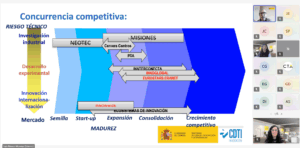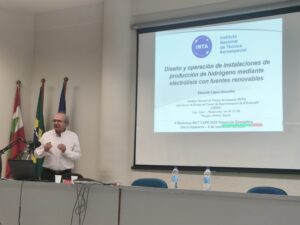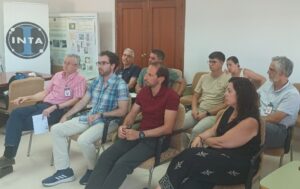Interview with Germán López Lara, Energy and Environment technical officer at Corporación Tecnológica de Andalucía (CTA) and member of AIHRE
Germán López is the technical manager of the Energy and Environment sector at Technological Corporation of Andalusia (CTA), a private foundation with 20 years of experience promoting business innovation in strategic sectors. With more than 185 member companies, CTA has a prominent international presence as a leading partner in collaborative innovation projects. Throughout its history, the foundation has participated in more than 65 international projects, funded by both the European Union and multilateral organisations, and has collaborated with more than 500 entities from 45 countries. In the European AIHRE project, CTA leads dissemination and communication tasks, with the aim of raising awareness of its progress and encouraging the participation of key players in the region.
- In broad terms, could you tell us about the AIHRE project, of which you are a member?
AIHRE is a project funded under the POCTEP programme, which promotes cross-border development and cooperation between Spain and Portugal. It focuses on analysing and promoting renewable hydrogen in this geographical area, specifically by strengthening collaboration between actors in the various renewable hydrogen value chains, including companies, public administrations, technology centres and universities. Among the objectives pursued through this cooperation is the consolidation of the innovation, scientific and technological ecosystem that contributes to improving business competitiveness in both Spain and Portugal.
The consortium comprises nine entities, four Portuguese and five Spanish, which have extensive experience in both the energy sector and in technological, business and entrepreneurial innovation processes. Thanks to the cooperation between the partners and their extensive knowledge, tools are being developed that will help renewable hydrogen play a more active role in our economy.
- What role do you think Spain and Portugal can play in leading Europe towards an economy based on renewable hydrogen? Are we in a position to be leaders in this field?
Spain and Portugal have a great opportunity to play a key role in a future decarbonised economy where electricity, mainly from renewable sources, energy efficiency, renewable energies and the use of renewable hydrogen will stand out as basic pillars. Both countries have high renewable resource potential thanks to their high levels of solar irradiance, as well as the existence of constant winds with moderately high speeds, in addition to significant biomass potential. These renewable resources are mainly being used to generate electricity and heat to meet part of the energy demand of industries and buildings.
However, renewable electricity can also be used to produce hydrogen, which can either be consumed by industries that use it directly in their processes (steel production, fertiliser production, the chemical industry, etc.) or exported to other European countries where both hydrogen and its derivatives (methanol, ammonia, etc.) are consumed. Examples of processes that consume hydrogen and its derivatives include those carried out in the industrial centres located in Huelva and Campo de Gibraltar, around which the Andalusian Green Hydrogen Valley is being developed, which will enable the production, consumption and export of hydrogen generated from renewable sources. In addition to supporting the decarbonisation of industry, strengthening energy security, reducing dependence on imported fossil fuels and increasing energy self-sufficiency, this type of action will attract valuable investment in both Spain and Portugal, which will enable the creation of stable, high-quality jobs in both countries. The Iberian Peninsula, in this dynamic transition process in which we find ourselves, has the opportunity to become a leading centre for renewable hydrogen production in Europe.
- Which productive sectors or industries in Andalusia are showing the greatest commitment to this energy vector?
Among industrial sectors, the chemical industry, oil refining and agribusiness are leading the way in adopting renewable hydrogen and its derivatives. Andalusia has the advantage of having two important industrial hubs, in Huelva and Campo de Gibraltar, with companies specialising in activities dedicated to industrial gases, oil refining, the chemical industry, metallurgy, electricity generation, the manufacture of agricultural inputs and biofuels, etc. Hydrogen has been consumed in these centres for a long time, although it is non-renewable hydrogen - mainly grey hydrogen, as it is generated from natural gas through a steam reforming process - and several of these consumer companies are seriously committed to replacing it with renewable hydrogen.
In line with this, MOEVE's UNOBA project has recently been approved, which will not only reduce the consumption of non-renewable hydrogen at the La Rábida Energy Park, but will also contribute to the decarbonisation of other industrial sectors. In this latter regard, it should be noted that hydrogen has a number of technical characteristics that make it attractive for playing a very active role in the decarbonisation of energy-intensive sectors, mainly those whose electrification is particularly complex, such as steel, chemicals, maritime transport, air transport and heavy road transport. In addition, it can also help to stabilise the electricity grid by balancing the time lags between electricity demand and intermittent renewable electricity generation, as well as minimising the curtailment of renewable electricity, which is currently on the rise.
- In your opinion, what are the main challenges facing the deployment of renewable hydrogen, both in Andalusia and in Spain and Portugal as a whole?
There are several challenges that must be overcome in order to accelerate the deployment of renewable hydrogen. Both Spain (especially Andalusia) and Portugal have seen significant progress in installed renewable capacity, particularly solar photovoltaic and wind power in Spain, and hydro and wind power in Portugal. This has enabled more than 55% of the annual electricity generated to be renewable in all these regions during 2024, reaching as much as 80% in certain situations. However, it is essential to invest in smart and resilient electricity grids to enable the effective integration of intermittent renewable technologies such as solar photovoltaic and wind power. This aspect is critical not only to ensure the stability of the electricity supply, but also to boost the production of renewable hydrogen from water electrolysis using electricity from renewable sources.
In addition, the administrative procedures for accessing and connecting to the electricity grid are proving to be an obstacle to the development of projects. Specifically, in order to facilitate the implementation of these projects, progress must be made in terms of regulatory clarity and administrative simplification.
Another significant challenge is the shortage of hydrogen refuelling stations, as well as continuing to promote and accelerate the construction or adaptation of gas infrastructure such as the Spanish Hydrogen Backbone Network, the H2Med corridor and associated storage facilities. Without the adequate development of this strategic infrastructure, there is a risk of not taking full advantage of this opportunity, as has happened not so long ago with other energy technologies, both in Portugal and Spain.
On the other hand, although electrolysis technology is well known and there are various alternatives (alkaline, polymer membrane, solid oxide, etc.), further progress must be made in improving the efficiency of electrical conversion to hydrogen, increasing the durability of electrolysers, using more readily available materials, etc. In short, research and innovation must continue with the main objective of reducing costs so that renewable hydrogen production systems can compete with conventional systems.
The electrolysis process requires both electricity and water. I have previously discussed the challenges associated with the availability of electricity from renewable sources, as well as minimising its consumption during electrolysis. For this reason, and in relation to water, actions must be taken to ensure more efficient management, including promoting seawater desalination using renewable energy sources and the use of wastewater. In Andalusia in particular, due to low water reserves and increasingly frequent periods of drought, special attention must be paid to efficient management aimed at preserving the availability and quality of water resources.
- Beyond its energy potential, what impact do you think green hydrogen could have on our region economically and socially?
The production, use and transport of renewable hydrogen and its derivatives not only represents an energy solution that contributes to the decarbonisation of the economy, but also a transformative opportunity for the economic and social fabric of Andalusia, Spain and Portugal. Thus, its impact will have a positive effect on both strengthening industrial activity and creating jobs in these regions.
In Andalusia, renewable hydrogen is emerging as a vector that can contribute to decarbonising industry and, in particular, further revitalising the industrial hubs of Huelva and Campo de Gibraltar with a significant business fabric committed to decarbonising its processes and energy consumption. The development of the Andalusian Green Hydrogen Valley will represent an investment of around €3 billion, with an estimated 10,000 jobs being created, 1,000 of which will be direct. Training programmes for young people and local workers are already being promoted, which will help to raise their skill levels and provide an adequate response to the needs of the profiles required by companies.
At the same time, it will provide a significant boost to Andalusian SMEs, which will be able to benefit from this context that will be generated around the renewable hydrogen ecosystem, from companies with activities focused on renewable plants or component manufacturing, to engineering firms and actors specialising in construction, maintenance or auxiliary services.
In short, the outlook is positive, as renewable hydrogen has the potential to generate quality employment, attract investment and strengthen industrial activity. However, for this impact to materialise properly, it will be essential to accompany it with tools that facilitate investment, as well as to develop specialised training programmes to ensure the availability of skilled workers.
- Finally, would you like to share any thoughts on the importance of collaborative initiatives such as AIHRE?
Renewable hydrogen has significant transformative potential for southern Europe, and collaborative projects such as AIHRE aim to be catalysts in this transition. As a support measure, we have launched the AIHRE Ecosystem, which aims to develop a community of actors committed to promoting the use of renewable hydrogen in the cross-border area between Portugal and Spain. The members of this community, currently more than 70 entities, have access to information on events related to renewable hydrogen, participate in workshops and networking sessions, and are located on an interactive map that shows their capabilities and interests with the aim of increasing their visibility and facilitating future collaborations.
This AIHRE Ecosystem serves as an example to show the advantages of supporting collaborative initiatives in this sector, as synergies are developed that help strengthen the value chains of renewable hydrogen, which is an energy vector that is here to stay and presents a great opportunity for Spain and Portugal to not only strengthen a sustainable industry and generate skilled employment, become key players in the production and export of renewable hydrogen and, therefore, in the transition towards a more decarbonised, distributed, autonomous and sustainable energy model.







